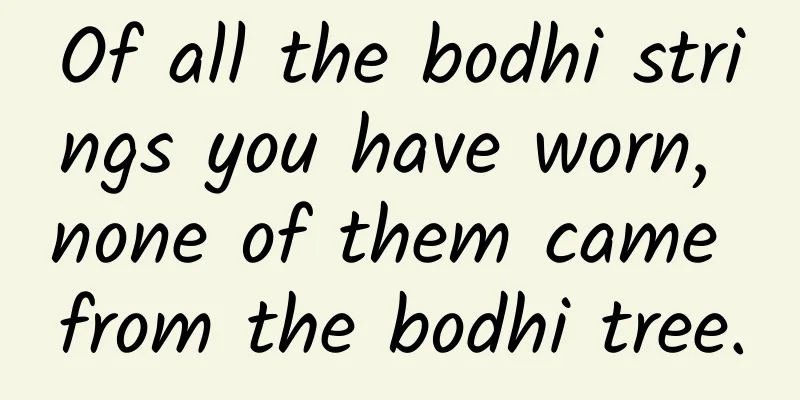Of all the bodhi strings you have worn, none of them came from the bodhi tree.

|
The products with the lowest threshold and the highest sales volume in the current cultural and antique market are the various Bodhi seeds . If you go into any cultural and antique market or shop, you can basically see things of various sizes and shapes that look like plant organs and are named "such and such Bodhi seeds". One of the most frequently asked questions about these Bodhi seeds is: Are these seeds from the Bodhi tree? It was another full moon night in Bodh Gaya. Under a huge tree, a meditator sat cross-legged, looking emaciated and without joy or sorrow. He had been meditating under the tree for forty-nine days. For the past six years, he had been living a life of meditation and asceticism. The Legend of Mahabodhi Forty-nine days ago, he came to Bodh Gaya, to the legendary ancient Ashvata tree, which is so huge that some people say its roots are in the sky, and it is an eternal tree of life that will live until the day the world is destroyed. Others say that this place connects all the worlds. The Maha Bodhi tree, under which Gautama Buddha is said to have practiced Buddhism | Neil Satyam / Wikimedia Commons The trunk of the giant tree with lush branches and leaves was as vigorous as a dragon, with thousands of branches twisting and drooping from high above. The moonlight was like a thread, and the shadows of the trees were mottled. On the huge tree canopy that covered the sky and the earth, the leaves rustled without wind. A drop of raindrops slid from the tip of a shiny heart-shaped leaf, which was as thin as a tail, and fell to the ground, shattering into countless crystals. At this moment, the meditator opened his eyes. This sculpture shows King Ashoka building a temple next to the Mahabodhi tree | Biswarup Ganguly / Wikimedia Commons In various legends and records that have been passed down for thousands of years, this moment has become an eternal legend in the history of human civilization. Siddhartha Gautama, who abandoned the throne of the prince of Kapilavastu, realized the right way under the tree at this moment and became the Buddha Shakyamuni. The towering Ashvatha tree in Bodh Gaya that witnessed the Buddha's enlightenment is the Bodhi tree . "Bodhi" is the transliteration of the Sanskrit word "bodhi", which means "enlightenment". It refers to a person who suddenly realizes the truth and becomes extraordinary from then on. This is also the origin of the name of the Bodhi tree. Because the Buddha attained enlightenment under the Bodhi tree, this tree has the power to enlighten people's minds and thinking, and is also called the tree of enlightenment and the tree of thinking. In many places in the world, where the Buddha's light shines, the Bodhi tree is always respected. Today, the Mahabodhi tree has become a popular Buddhist shrine. | Vinayaraj / Wikimedia Commons In the first year of Tianjian (502 AD) during the Northern and Southern Dynasties, a monk from India, Zhiyao Sanzang, sailed to Guangzhou and planted a Bodhi tree he brought with him in front of the ordination platform of Guangxiao Temple. Time has passed, and Guangzhou Guangxiao Temple has become the oldest existing Buddhist temple in Lingnan. There is an old Bodhi tree in the temple with lush branches and leaves, and it has also witnessed many legends. It is said that the Sixth Patriarch of Zen Buddhism, Master Huineng, once preached here and chanted a poem under the Bodhi tree: There is no Bodhi tree, and the bright mirror is not a stand. There is nothing originally, so where can dust be raised ? A giant tree that can make a forest of trees The Ficus genus is a large genus with nearly a thousand species of trees, shrubs and vines, most of which are found in tropical and subtropical regions. The Bodhi tree, which helped the Buddha "attain enlightenment", is one of the nearly a thousand species of Ficus . The Bodhi tree is native to Southeast Asia and India, and is also naturally distributed in southwest China. Bodhi tree growing in a field | Dinesh Valke / Wikimedia Commons Today, there are Bodhi trees in many Buddhist temples in southern China and Southeast Asian countries. Many of these Bodhi trees have been certified or attributed by interested people to be descendants of the sacred tree in Bodh Gaya. Compared with other banyan trees, the Bodhi tree has leathery triangular-ovate leaves that are dark green and shiny. The tip of the leaf has an extremely narrow and elegant tail tip. This impressive "little tail" is called the "drip tip". The little tail on the Bodhi leaf can make the water film on the surface of the leaf gather into water droplets that drip down the tip of the leaf, making the leaf surface dry quickly. This is also a strategy for tropical plants to adapt to rainy environments . The Bodhi tree also has slender petioles that are almost as long as the leaves. Even when there is no wind, the long petioles and wide leaves can make the leaves sway constantly. The dripping tip of a bodhi tree | Marshman / Wikimedia Commons Like many banyan trees, the Bodhi tree can continuously produce hanging aerial roots from its branches . When the aerial roots touch the ground, they can take root in the soil and grow into new trunks. The Bodhi tree has a long lifespan. Time can allow it to grow into a huge tree . Thousands of hanging aerial roots can grow around the main trunk, which will always witness and record the changes of time. The recognizable aerial roots of Ficus plants | Wknight94 / Wikimedia Commons From then on, one tree becomes a forest. However, the life of such a huge banyan tree may have started from an inadvertent journey. Their inconspicuous seeds were excreted by birds in the cracks of a tree . The seeds of this Bodhi tree quietly sprouted, and the weak young plant of the Bodhi tree tried to attach to this tree. Relying on rain and air, the young plant tried to maintain its life and continuously produced aerial roots hanging downward. Finally, the first aerial root grew to the ground and took root in the soil of the forest floor. Those who are unlucky will fall into the cracks of the wall | Deepanshu1707 / Wikimedia Commons From then on, the seemingly fragile young Bodhi tree was no longer "Buddha-like". New aerial roots continued to reach the ground and take root. The above-ground parts of these roots turned into tree trunks while continuing to sprout and take root. They began to surround and "strangle" the tree it once relied on when it was young . The “meat” in figs One flower, one world; one leaf, one bodhi. In people's eyes, the bodhi tree can bear a full tree of figs, but except for various slightly scary marketing accounts, most ordinary people have never seen the bodhi tree bloom. Unripe fig fruit | Woodlot / Wikimedia Commons The characteristic of the Bodhi tree that it bears fruit without blooming is very similar to that of the fig. Both the Bodhi tree and the fig belong to the genus Ficus . As members of the Moraceae family, both have the typical characteristic of the genus Ficus - cryptic inflorescence. It is not that the Bodhi tree does not bloom, it is just that we cannot see it from the outside. The inflorescence is a special inflorescence structure, the inflorescence axis is fleshy and swollen, and concave downward, forming a hollow ball, and the concave inner wall of the ball is densely covered with small white flowers without peduncles. Inflorescence | couleur / Wikimedia Commons This hollow sycamore inflorescence has only a small hole at the top for pollinating fig wasps to enter and exit. After squeezing in through the small hole at the top of the sycamore inflorescence, the female fig wasp will lay eggs on these gall flowers, and then the larvae will develop here. The mature new generation of fig wasps will complete mating in the inflorescence, and the female wasp will carry the pollen of the male flower through the small hole to find a new sycamore inflorescence . If it is lucky enough to drill into the female plant inflorescence, it can bring the pollen to the female flower stigma and then complete the mission of pollination. A cut sycamore showing the florets and fig wasps | Barbara van Amelsfort / Wikimedia Commons Figs are both the "home" and food of these fig wasp larvae. In the long history of evolution, the Bodhi tree and the fig wasp have established a mutually beneficial symbiotic relationship. The Bodhi tree provides a "carefree" living environment for the fig wasp throughout its life, while the fig wasp helps the Bodhi tree to pollinate and bear fruit. Even hidden in the inflorescence, the eggs of fig wasps are not safe. Some species of parasitic wasps have long ovipositors that can pierce the "wall" to complete the parasitism of the host | JMK / Wikimedia Commons Figs are estimated to be between 60 and 100 million years old, and their survival and reproduction are entirely due to fig wasps, and vice versa. In the history of evolution, all long-lasting collaborations are those that have been tested and remain fresh over time. Author: Meow Meow Plant Control This article comes from the Species Calendar, welcome to forward If you need to reprint, please contact [email protected] |
<<: Popular Science Illustrations | How much do you know about atmospheric background stations?
Recommend
Volkswagen closes German factory, Blume is willing to "get a speeding ticket" to enter the Chinese time
"The situation is very serious." This i...
How to organize activities with 0 budget and still attract and retain a large number of users!
I. Introduction, my understanding of activities 1...
How to be immune to fake traffic?
In recent years, China's Internet has faced a...
The secret of increasing followers: operators must learn to cooperate
There are many miscellaneous tasks in operations ...
How much does it cost to attract investment for the Wuhu Big Roulette Mini Program? What is the investment price for the Wuhu Big Roulette Mini Program?
Is it easy to attract investment for the Wuhu Big...
China Passenger Car Association & Anluqin: The new four modernizations index of passenger cars in April 2021 is 66.1
The Passenger Car New Four Modernizations Index, ...
Thousands of years of wisdom shine today! The 24 solar terms have been included in the World Heritage List for five years!
Five years ago November 30, 2016 The “Twenty-Four...
When will Changsha pick stars in 2022? What is the specific time for unblocking? Attached is the latest news on the epidemic!
Recently, new cases have appeared in Shanghai, Jil...
It took seven years for the business to make a profit, just because of the deep love for football
Loving football is an essential gene for every me...
30 high-quality cases in 18 industries, a must-read for information flow delivery!
This article shares with you 30 high-quality case...
Are highways free during the Dragon Boat Festival? 2020 Dragon Boat Festival Holidays and Highway Tolls
How many days will the Dragon Boat Festival be th...
Can you travel around the world with just a stretch of your hand? Palm recognition is more useful than face recognition!
□ Popular Science Times reporter Chen Jie Stretch...
Want a “screen-sweeping” promotion for NetEase Music? Here are 8 ways
Why does the traffic increase when users are mock...
2022 Nanjing tea service recommendation, you will definitely regret it if you don’t come once
2022 Nanjing tea service venue recommendation: [1...
B station places advertisements, and the forms of B station advertisement display
Some time ago, Bilibili released its Q3 financial...









